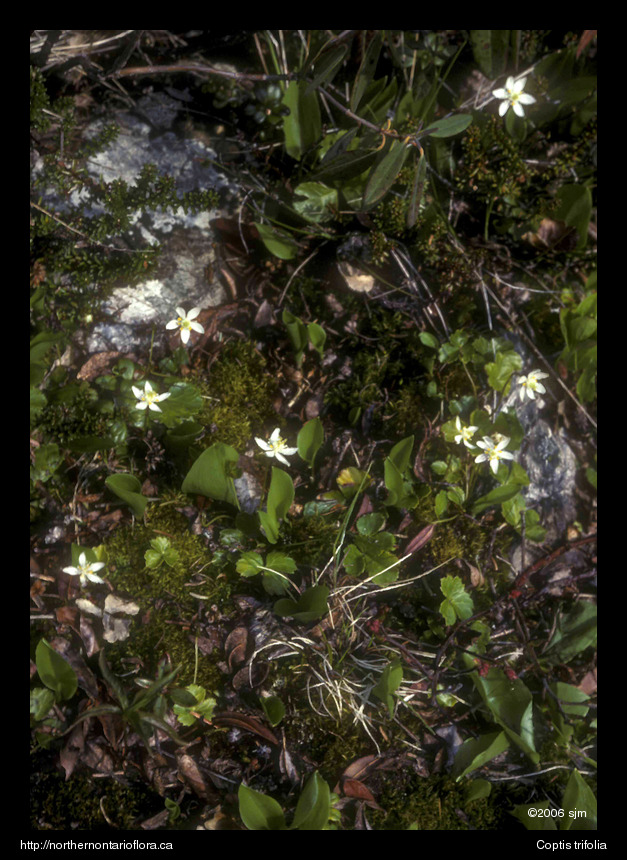
|
Northern Ontario Plant Database 
Plant DescriptionCoptis trifolia (L.) Salisb.En: goldthread, canker-root, yellow snakeroot
Ranunculaceae (Buttercup or crowfoot Family) General: A low, perennial forb, to 17 cm tall, the plant smooth (glabrous), spreading by thin, bright yellow rhizomes, which have a bitter taste. Eastern North American plants were formerly separated as Coptis groenlandica (Oeder) Fernald, but this distinction is no longer recognized. Leaves: Basal, evergreen, compound, dark green and very glossy when young. Leaves divided into 3 leaflets (trifoliate). Leaves long-stalked, leaflets short-stalked. Leaflets obovate and shallowly lobed toward the tip; bases tapering (cuneate); apices and marginal teeth bristle-tipped. Flowers: Bisexual; the solitary flower situated on a stalk (peduncle) 3–17 cm tall; flowers 1–1.5 cm wide. Sepals 5–7, white, petal-like, elliptic to oblanceolate, 1–3.6 mm wide, deciduous; petals 5–7, yellow, very reduced and fleshy, modified into narrow, club-shaped (clavate) nectaries with a depression at the tip, alternating with the petaloid sepals; stamens numerous, longer than the short, nectar-producing (nectariferous) petals; pistils 3–9, erect; the superior ovaries each taper to a curved style that persists as a beak on the fruit. Flowers bloom in April to May. Fruit: A cluster of 3–9 dry fruits (follicles), elliptic, 4–7 mm long (excluding the beak), spreading (divergent), each short-stalked and topped by a narrow beak, 2–4 mm long. Habitat and Range: Moist, usually mossy conifer forests and swamps. Goldthread occurs throughout the boreal regions of North America and Eurasia, and throughout northern Ontario. Internet Images: The Coptis trifolia webpage from the Gallery of Connecticut Wildflowers, website of the Connecticut Botanical Society. This image of a Coptis trifolia flower shows the bright yellow nectariferous petals alternating with the white sepals; from The Digital Flora of Newfoundland and Labrador Vascular Plants website. Notes: The somewhat shiny, evergreen leaves that persist through winter are soon replaced by young, paler, glossy leaves soon after flowering begins. Goldthread, with its distinctive trifoliate leaves and small star-like flowers scattered across the forest floor in early spring, is not easily confused with other species. Back to species list |
||||||||||||||||||||||











